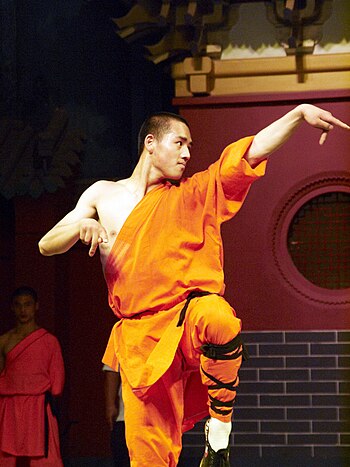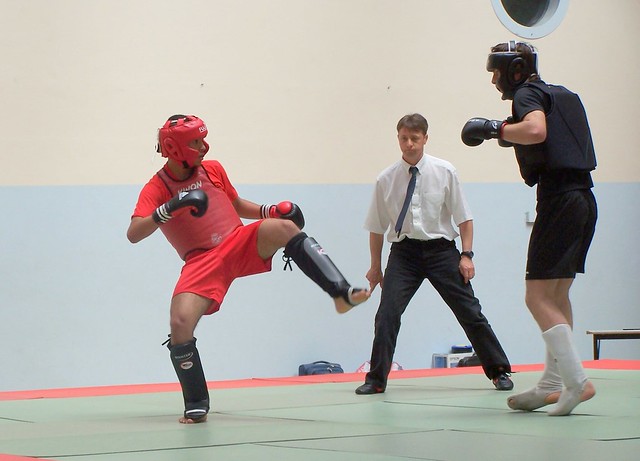A karate student wearing a karategi
(Photo credit: Wikipedia)
For many people, especially those who are not familiar with martial arts, the question often arises on what the difference between karate and kung fu is. Upon watching somebody doing martial arts, the untrained eye will find it hard to tell whether that person is doing karate or kung fu. Even those who are beginning martial arts may sometimes be confused about the different styles until further exposure to them will reveal just how different they really are.
Historically, the people living in the islands of Okinawa just south of Japan got exposed to Chinese kung fu martial arts due to the close proximity to China. Over time, the Okinawans and Japanese developed their own styles of martial arts now known as karate from the original influence of Chinese kung fu. Although both karate and kung fu utilize many similar martial arts techniques, most kung fu styles will usually have more variety of techniques compared to karate systems. It’s almost like the Japanese streamlined the number of techniques from Chinese systems to develop karate. The Japanese also modified the way techniques are executed in karate as they became more linear compared to kung fu. This is especially evident in the forms or katas (traditional sequence of set moves) where karate techniques are performed with crisp movements that have distinct stop and go motions.
In kung fu forms, movements involve the use of more circular techniques, particularly with the hands. These circular motions give kung fu forms a more visually graceful look as techniques seem to flow from one to another. There is less stop and go with most kung fu styles. This is why some martial artists, especially in North America, often refer to Chinese kung fu as ‘soft’ styles while karate and tae kwon do are ‘hard’ styles. This is not to say that hard styles such as karate or tae kwon do are more powerful martial arts than kung fu and other soft styles. The term ‘soft’ is a bit misleading because the power from circular kung fu moves is often hidden. Circular moves can generate just as much power as linear ones found in hard styles. Most kung fu forms are also usually more complex and longer in duration than most karate forms. To most martial artists, a kung fu form will look much more exotic while a karate form will look more straightforward in terms of martial arts techniques. Interestingly enough, there are karate styles such as Goju which do have quite a lot of circular techniques similar to kung fu. Kempo styles are considered a hybrid of Chinese kung fu and Okinawan karate techniques with both circular as well as linear techniques. There are also many more different styles of kung fu compared to karate.
 |
| A Shaolin student doing a kung-fu moves. (Photo credit: Wikipedia) |
Martial arts weaponry is found in both kung fu and karate styles but different sets of weapons are utilized in each martial arts system. Much like the empty hand forms, the kata with karate weapons is also more linear compared to those with kung fu weapons which have more circular movements. As expected, there is a lot more variety of different Chinese kung fu weapons than found in the Japanese karate styles.
Traditionally, practitioners of karate wear a white uniform called a gi which features the overlapping kimono-like top. Less traditional schools like those in North America will allow colored uniforms. A colored belt will be the finishing touch to the gi with of course the black belt for those at instructor level ranking. Most of the time and especially inside a dojo studio, karate stylists will not wear any shoes while training. Most kung fu stylists will wear a very different looking uniform. Kung fu uniforms usually consist of tops with Chinese ‘frog-style’ buttons rather than overlapping fronts like the karate gi top. The uniforms can be black or a variety of colors with often lighter fabrics such as satin and shoes are commonly worn. The modern acrobatic Chinese martial arts of wushu can feature satin uniforms with many different bright colors. Many kung fu schools simply utilize t-shirts and baggy pants as uniforms. Satin colored sashes are often worn to signify rank of students but this is actually more of a North American style as most kung fu schools in Asia do not show rankings in uniforms.
Overall, there’s more variety of techniques, styles, weapons, and uniforms found in the Chinese kung fu systems compared to karate. However, that is not to say that one system or style of martial art is superior to another. They are just different and to the observer, it could come down to personal preference. Some prefer kung fu and some prefer karate. Some ambitious martial artists who desire a full well-rounded education practice both kung fu and karate.






